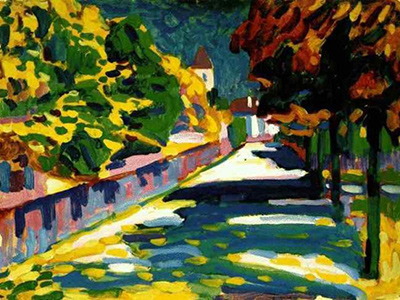For years prior to 1908, Wassily Kandinsky had been painting landscapes in a highly stylized manner. With 'Autumn in Bavaria', however, he would push it farther towards pure abstraction than at any time previously.
Granted, the viewer can still clearly make out the visual elements in this scene; there are the beech trees to the right of the foot path, the spruces and other voluminous evergreens on the other side of it above the short retaining wall, and in the background one can clearly see a Church with its spire.
Nonetheless, Kandinsky's use of what at the time were highly unconventional brush strokes - for the first time in this painting we can see the use of the palette knife on the canvas board- foreshadow what was to come in Kandinsky's trajectory as a painter.
In much the same way that Henry Van de Velde broke with the floral motifs and representational forms for designs borne purely of the imagination, in 'Autumn inb Bavaria' we can see Wassily Kandinsky breaking away from painting's past and heading into uncharted territory. As such, although it is still a landscape, 'Autumn in Bavaria' ught also to be considered as an incipient piece of abstract painting.
Russian born painter Wassily Kandisky is heralded as an original theorist and practitioner of abstract art. He started painting relatively late in life at thirty years of age in 1896.
At any rate, he took to his new lifework with a great sense of imperativeness, and even went so far as to move from Moscow to Munich to study under the Slovene master realist Anton Azbe. In doing so, Kandisky had left behind an auspicious career as a lawyer.
The turn of the twentieth century was a very propitious time to be in Munich for up and coming and forward thinking artists. The Bavarian capital was the epicenter of the Jugendstil movement, the German strain of the 'Art Nouveau' movement that was manifesting itself all over Europe at the time (the word Jugendstil translates as "Youth Style").
To understand Kandisky's progression from representational works to pure abstraction, it helps to understand a little bit about the development of Jugenstil in Germany at the turn of the century.
Prior to 1900, Jugenstil consisted mainly in purely decorative floral motives that were clearly influenced by English Art Nouveau and Japanese ukiyo-e woodblock prints. However, as of 1900 and afterwards, Jugendstil starts to tend strongly towards purely abstract forms, and the influence of the Belgian architect and designer Henry Van De Velde is quite apparent.
Although a Belgian, Ven De Velde had received the majority of his critical praise and recognition from notable German publications such as Innen-Dekoration (interior design). Thus, in 1899 he settled in the city of Weimar in the German state of Thuringia.
By 1905 he had successfully established the seminal Grand-Ducal School of Arts and Crafts with the full support of the Arch Duke of Weimer. During this time Van De Velde would appropriate the boldly modern curvilinear forms he had developed as a furniture designer for use in printmaking, sculpture, textiles and other mediums. Van De Velde's carpet designs, for instance, are highly articulated and precise forms that have absolutely no counterpart in nature, be it floral or otherwise.




